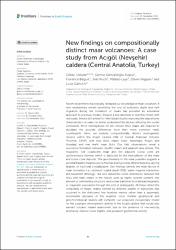New findings on compositionally distinct maar volcanoes: A case study from Acıgöl (Nevşehir) caldera (Central Anatolia, Turkey)

View/
Date
2022Author
Uslular, GöksuGençalioğlu Kuşcu, Gonca
Bégué, Florence
Ruch, Joël
Lupi, Matteo
Higgins, Oliver
Caricchi, Luca
Metadata
Show full item recordCitation
Uslular G, Gençalioğlu Kuşcu G, Bégué F, Ruch J, Lupi M, Higgins O and Caricchi L (2022), New findings on compositionally distinct maar volcanoes: A case study from Acıgöl (Nevşehir) caldera (Central Anatolia, Turkey). Front. Earth Sci. 10:909951. doi:10.3389/feart.2022.909951Abstract
Recent experiments have largely reshaped our knowledge of maar volcanism. A new evolutionary model promoting the role of explosion depth and vent migration during the formation of maars has provided an alternative approach to previous models. Despite a few attempts to test this model with real cases, there is still a need for field-based studies exploring the depositional characteristics of maars to better understand the factors affecting the model constraints. More investigations on less known felsic maars are required to elucidate the possible differences from their more common mafic counterparts. Here, we explore compositionally distinct monogenetic clusters within the Acıgöl caldera (NW of Central Anatolian Volcanic Province, CAVP), with four felsic maars (İnallı, Kalecitepe, Acıgöl, and Korudağ) and one mafic maar (İcik). Our field observations reveal a successive formation between rhyolitic maars and adjacent lava domes. The mugearitic İcik coalescent maar and the adjacent scoria cone are synchronously formed, which is disclosed by the intercalation of the maar and scoria cone deposits. The geochemistry of the maar juveniles suggests a parental basaltic magma source that has been possibly differentiated by varying degrees of fractional crystallization. Our findings identify the main factors in maar formation (i.e., optimum scaled depth-OSD, water-magma interaction, and basement lithology). We also determine some differences between the felsic and mafic maars in the region, such as higher juvenile content, less amount of sedimentary structure, and a clear transition from phreatomagmatic to magmatic explosions through the end of stratigraphy. All these reflect the complexity of maars, mainly formed by different depths of explosions that occurred in the shallowest few hundred meters rather than a systematic incremental decrease of the eruption locus. Further geophysical and geochronological studies will complete our proposed evolutionary model for the youngest monogenetic activity in the Acıgöl caldera that would also warrant volcanic hazard assessment due to the presence of low-velocity anomalies, shallow Curie depths, and prevalent geothermal activity.

















